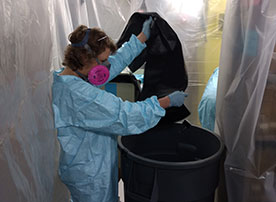- Revisit your organization’s list of priority collections (vital records) and their locations.
- Verify your facilities’ layouts, paying attention to evacuation routes and locations of stairs, exit doors, fire hoses, water and CO2 fire extinguishers, emergency lights, alarm pull boxes, sprinkler shut-off valves, and first-aid kits.
- Hold a planning meeting with staff today.
- Know what's coming your way. Track the weather.
- Back up your electronic records and store the backup in a safe place off site.
- Move priority collections out of basements and off floors.
- Check in now with service providers for generators, freezers, drying and freeze-drying services, and refrigerated trucking.
- Gather plastic sheeting to cover collections, filing cabinets, and computer equipment stored in vulnerable locations.
State Archives Services and Funding
The Local Government Records Management Improvement Fund (LGRMIF) grant program offers the opportunity for New York State local governments to compete for funding in multiple categories, including disaster management. Funds are available to develop, test, and implement disaster and business recovery plans and systems to protect local government archival and vital records. Contact your Records Advisory Officer (RAO) for more information.

